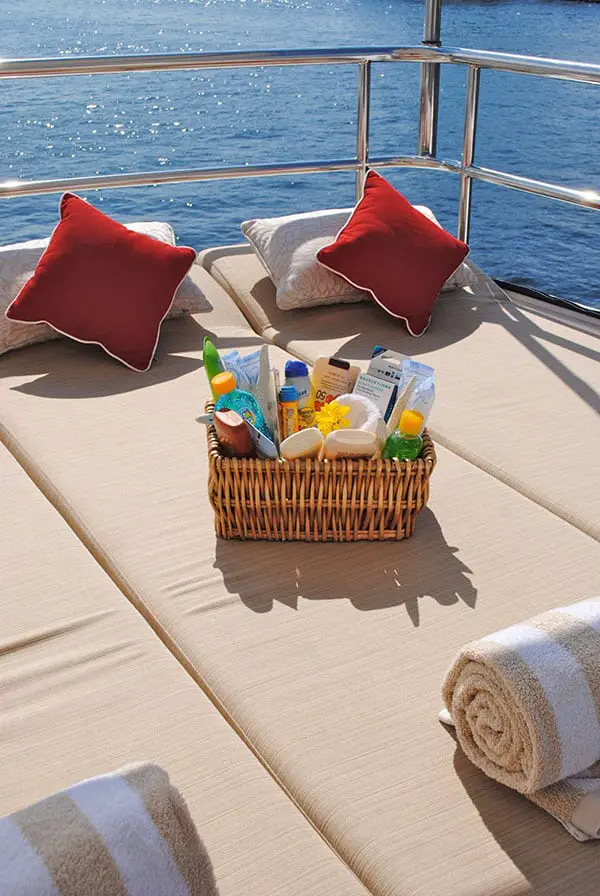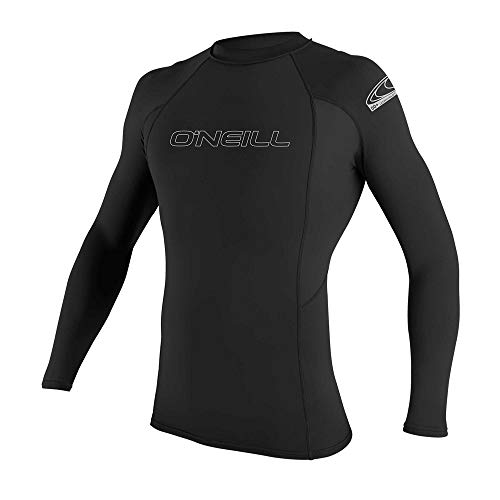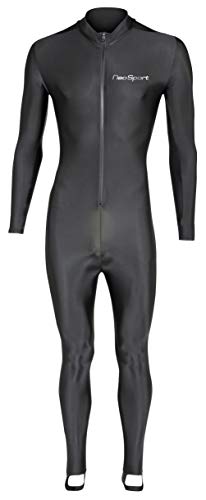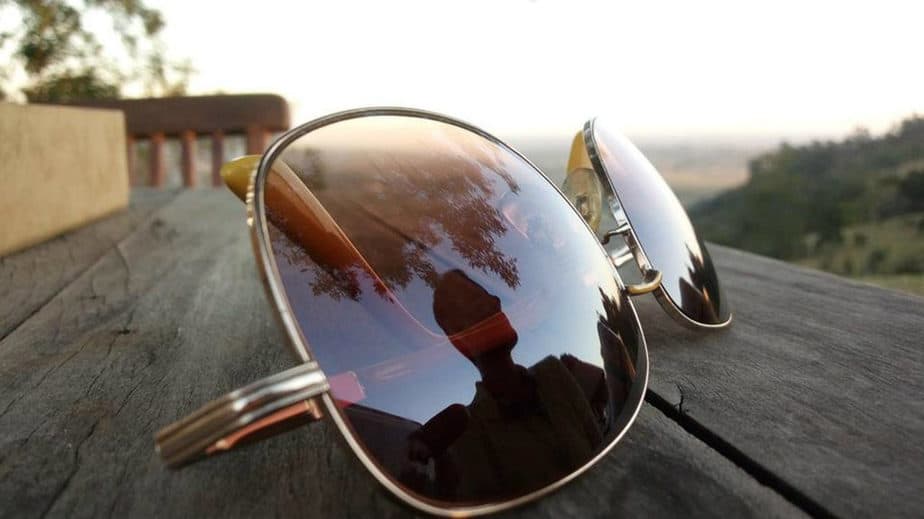Imagine the gentle warmth of the sun as it envelops your skin in its embrace. Just thinking about it probably puts you at ease and brings a smile to your face. And that’s exactly what you’ll be experiencing as you’re about to head into the water to snorkel on a beautiful, sunny day.
While moderate amounts of exposure to the sun is great for snorkeling and relaxing, too much will quickly end your vacation in a combination of bright red skin and painful, burning sensations. Not only are sunburns painful, but exposure to harmful UV rays can lead to skin problems like sun damage, melanoma, and skin cancer. To prevent this, you need some snorkeling sun protection in the form of sunscreen and snorkeling gear with high UPF ratings.
In this guide, we’ll go over how sunscreen and various protective snorkeling gear can protect your skin from harsh UV rays so that you can experience the sun’s warmth without any of the side effects.
Ultraviolet Radiation (UV Rays) and How It Impacts Your Skin
When you’re at the beach, there are two types of UV rays that will affect you: UVA and UVB.
UVA: Due to its wavelength, UVA rays are not absorbed by the Earth’s ozone layer, penetrating through it and deep into your skin, causing it to age faster.
UVB: The ozone layer only partially blocks UVB rays, and this is the radiation that causes your skin to get burnt.
If you’re not sure how to distinguish between the two, think of the ‘A’ in UVA as standing for aging, and ‘B’ in UVB as standing for burn. Both are harmful when the skin is exposed to them and can cause skin cancer.
Types of Sunscreen
Sun protection creams generally fall into two categories: absorbers and reflectors.
Absorbers: Often referred to as sunscreen, these products absorb the UV rays and keep them from reaching the skin.
Reflectors: Often referred to as sunblock, deflect harmful UV rays away from the skin.
Both sunscreen and sunblock are manufactured using various chemical compounds. For example, many absorbers are made using the ingredients benzophenones and parasol. And many reflectors are made with titanium dioxide and zinc oxide as the primary ingredients.
Sometimes people will have allergic reactions to one, but that doesn’t mean you are incapable of protecting your skin with sunscreen or sunblock. Try another one that uses different ingredients. Reflectors, or sunblock, tend to be suitable for people with sensitive skin.
Selecting a Sunscreen
Sun Protection Factor (SPF)
The Sun Protection Factor, or SPF for short, measures how effective the sunscreen protects your skin against UVB exposure, and the number will be printed at the front of the container. The most common SPF ratings are 15 and 30, but sunscreen with SPF-50 and higher are also available.
The SPF number is a reference to how much longer you can stay in the sun before getting sunburnt than without it. So with SPF-15 sunscreen, you can stay out 15 times longer than without protection, and with SPF-30 you can stay out 30 times longer than normal in ideal conditions. So for instance, if you normally get sunburnt after 30 minutes, then with SPF-15 sunscreen you can be out for 15 * 30 minutes = 450 minutes in optimal conditions.
But wait! That’s not telling the whole story. When you’re snorkeling, you will expose the sunscreen to water. Even under normal circumstances, you will sweat and any physical activity can cause the sunscreen to rub off. Therefore, just to be on the safe side, it is recommended that you reapply sunscreen every one to two hours when snorkeling no matter the SPF rating.
In addition, it is recommended that you look for broad spectrum sunscreen that can protect you against both UVB and UVA radiation. In terms of effectiveness, research has shown that sunscreen with SPF-15 can block 94% of UVB radiation, and SPF-30 blocks 97%. SPF-50 can block 98% of UVB radiation, which is only a 1% difference from SPF-30. At SPF-100, 99% of UVB radiation is blocked.
As you can see, there is not much point going higher than SPF-30, as you get significant diminishing returns. Higher SPF sunscreen costs more and can expose your skin to high concentrations of chemicals that may cause irritation over time. A good rule of thumb is to look for broad spectrum SPF-15 sunscreen for all-around protection at the lowest price.

Waterproof
Since you want to protect your skin while snorkeling, know that water and perspiration (your sweat) can wash sunscreen off your skin so you will not be getting the exact level of protection you thought you had. Purchase and use waterproof sunscreen to limit reapplication.
Generally, water-resistant sunscreen will start to wear off after 40 minutes in the water, and waterproof sunscreen after 90 minutes. The number can vary from product to product, so look at the label to get exact numbers and reapply when needed.
Sensitive Skin
If your skin has reactions to the sunscreen, that should not discourage you from using sunscreen. You just have to find the right one for you. Consider using a water-based sunscreen if your skin is prone to acne or is oily. Look specifically for sunscreens for sensitive skin, or for mineral sunblocks with the primary ingredients Titanium Dioxide and Zinc Oxide to reduce unwanted chemical reactions.
Avoid sunscreen with these ingredients: Para-Aminobenzoic Acid (PABA), Avobenzone, Padimate O, Homosalate, Octocrylene, Octisalate, Oxybenzone, Methoxycinnamate and Octinoxate.
Lastly, don’t make the mistake of thinking more expensive = more protection. As we’ve already covered, higher SPF rating makes a negligible difference in protection but will cost more.
Applying Sunscreen
First, shake the sunscreen container well. If you haven’t used it for a while, the compounds in the sunscreen will settle and clump up, providing less protection and making it hard to squeeze out.
Make sure to apply sunscreen evenly. Many people don’t put on enough sunscreen or miss areas like the ears, behind the knees, your lips, and the top of your feet. As a rule of thumb, the amount of sunscreen needed to cover your entire body should be roughly enough to fill a shot glass.
Maximizing Sun Protection
Apply sunscreen 30 minutes before going out. Doing so will allow the product to be absorbed into your skin and make it less likely to wash or rub off when exposed to sweat, water or physical contact.
Check the expiration date on the bottle. Was the last time you purchased sunscreen several vacations ago? The compounds in the sunscreen that absorb or deflect the UV rays can degrade over time, lowering its effectiveness and therefore its true SPF rating.
Don’t rely entirely on the sunscreen to protect you. Whenever possible, try to stay in the shade or wear clothing with a UPF rating. More on that below.
Wearing High UPF Clothing for Protection While Snorkeling
If you’re not a fan of applying and reapplying sunscreen multiple times each day, consider looking into high UPF clothing. Thankfully, most snorkeling gear such as rash guards and wetsuits have UPF-50 ratings, which not only absorb UVB rays but also UVA rays.
You can cover a large portion of your body wearing one, and you only need to apply sunscreen on the exposed skin. In addition to the UV protection, clothing has the practical benefit of keeping you warm and protecting you from physical harm, such as coral, jagged rocks, and jellyfish stings.
Here are some popular snorkeling gear that can protect you in the sun.
Rash Guards and Leggings
Rash guards were originally worn by surfers to keep their skin from rubbing against the surfboard and to provide some warmth. Nowadays, rash guards have found a variety of uses in all kinds of watersports, including snorkeling. Rash guards are either loose-fitting or form-fitting tops that are constructed from synthetic materials.
They come in long-sleeve and short-sleeve varieties, and they cover a large portion of the body from the sun’s UV rays. Similarly, swim leggings are like the pants equivalent of a rash guard. Not only do rash guards offer UPF protection against the sun, but they add another layer to guard against jagged surfaces or jellyfish stings.
Some companies have stepped their game up in the area of sun protection by offering UPF-50+ rash guards that come with wrist straps, attached hoods, and leggings with foot stirrups. Some products even work together by connecting the rash guard and leggings with small buttons to prevent the rash guard from riding up.
You can check out the selection of UPF-50 Rash Guards and Leggings over at Amazon.com.

Skinsuits
Next, there are snorkel skinsuits which you can think of as rash guard onesies. Like a wetsuit, a skinsuit covers your entire body and has to be zipped up. They are constructed from synthetic textiles and are form-fitting to keep too much water from entering and to reduce drag in the water. Skinsuits can be worn on their own, but they can also be worn underneath wetsuits for extra warmth. And of course, they have a UPF-50 rating.
Just like snorkeling rashies and leggings, skinsuits also feature thumbholes and foot stirrups to provide extra coverage on your feet and hands. You can find them in various sizes, from XS to XXXL, and can be worn by both men and women.

Wetsuit
In addition to the sun protection, if you plan on snorkeling in colder waters and need the extra insulation, then look for a neoprene snorkeling wetsuit. Wetsuits can cover the whole body including the arms and legs, or you can get a shorty wetsuit that exposes skin up to the mid-arms and mid-thighs. If you are snorkeling in a tropical destination, look for wetsuits that are 3mm or thinner.
Wetsuits are more expensive than rashies and skinsuits, but they can last a long time if you go through the effort to properly maintain them. If you partake in other water activities such as kitesurfing, SCUBA, or freediving, then definitely consider getting a wetsuit. One thing to keep in mind is that wetsuits designed for surfers and kiteboarders will have more flexibility than ones designed for scuba diving.
If you’re not sure which wetsuit is right for you, we recommend this one.

UPF Swimsuits
Not all swimwear provide much sun protection, however there are UPF-50 swimsuits that can save your skin when snorkeling.
Women’s swimsuits tend to have more coverage, since they can wear tops or one-piece swimsuits. Since the goal is sun protection, the more skin coverage the better. The added benefit is that you won’t be having any embarrassing flashing accidents when you’re all covered up. If you’re up to it, there’s no reason why women can’t wear men’s swim trunks with a top.
Men should look into getting board shorts to protect their legs down to their knees. Many people often pair this with a rash guard to provide UPF protection for the upper body.
UPF Headgear
For those who are bald, have thin hair, or have extremely short hair, the top of your head absolutely needs some form of UPF gear just like the rest of your body.
You can look into wearing a bandana, dive hood, or a swim cap.
What You Should Know About Sun Exposure
Many people put themselves at risk of sun exposure because they don’t realize some important facts that can really save their skin. Did you know that:
- How hot or bright the sun is has no correlation with the UV intensity. That is to say, even on cold days the UV rays it produces are just as harmful as on hot days.
- Even on cloudy days, 80% of the sun’s damaging rays can penetrate the clouds. If you’re going to be spending a long day outdoors, you must wear sunscreen.
- Most people will get sunburnt between the hours of 10am to 4pm, as that is when 60% of the day’s radiation occurs.
- Tanning oils or lotions are not the same as sunscreen. Sunscreen protects against UV rays, tanning oils will enhance the sun’s rays causing even more harm.
- Children spend three times longer outdoors in the sun than adults, so make sure they are wearing sunscreen and to reapply it every two hours.
- T-shirts only provide a UPF of 6.5, and even less when wet, so don’t rely on a regular shirt to protect you when snorkeling.
- Areas at higher altitudes will experience more UVB radiation. The higher you are, the closer you are to the sun, therefore the more at risk you are.
- The angle of the sunlight affects how much exposure there is on the Earth’s surface. For example, when the incoming rays are pointing straight down to the earth (at or near 90 degrees), there is less atmosphere absorbing the UVB radiation, which means locations near the equator have the highest risk for UVB exposure.
Protecting Your Eyes from the Sun
Your skin isn’t the only thing you need to worry about while snorkeling; your eyes need some love too! After all, even if you’re not looking in the direction of the sun, the sunlight can reflect off the surface of the water right into your eyes.
To reduce their effects, keep a pair of UV-blocking sunglasses with you when you’re on the shore or boat and getting ready to enter the water.
For snorkeling, look for black-skirted masks. The color black absorbs the most sunlight and may keep your eyes from getting fatigued by bright light. Furthermore, the glass lenses and silicone on high quality dive masks should protect your eyes against most UV rays.

Reef-Safe Sunscreen
Most sunscreens contain chemicals that harm the coral reefs. The details aren’t completely clear, but there is evidence that regular sunscreens that get washed off into the water can wreak havoc on wildlife and plants.
While this may seem like a small issue, and you may think that your impact on the planet’s health is insignificant, that is simply not true. Until there is irrefutable evidence that sunscreen is completely safe for the planet, environmentally-conscious people should aim to reduce the amount of sunscreen they use, especially those containing oxybenzone, butylparaben, octinoxate, and 4-MBC.
When looking for sunscreen, look for reef-safe sunscreen that doesn’t contain any of the above chemicals. The best thing to do is to wear high UPF clothing so that you don’t have to use much sunscreen, if any at all. If you have exceptionally fair skin, then apply sunscreen on uncovered areas such as your face and hands. Furthermore, we recommend using biodegradable and mineral-based sunscreen.
Additional UV Protection Tips for Snorkeling
Sun protection gear and sunscreen are crucial for keeping your skin safe from harmful UV radiation when you’re busy snorkeling. However, there are some additional ways you can stay safe, especially if you don’t like being covered head to toe and want to show off some skin. Something that people don’t take into account is when you decide to snorkel, whether it is what time during the day, to what time during the year.
When to Snorkel During the Day
In our What You Should Know About Sun Exposure section we revealed that the UV radiation levels are at their highest from around 10am to 4pm. Thus, we recommend you start your snorkeling session either several hours before 10am, or slightly after 4pm when the UV rays are weaker.
Essentially, you would be snorkeling either early in the morning or in the evening. The implications of this are wonderful! In the morning, the waves are calmer and safer. Furthermore, the wildlife will most likely be more active. The same is true for trips at dusk. If you truly want the best sights, especially if you plan on filming or taking pictures, you will find more wildlife to record and the lighting at these times are better as well.
If you’re feeling particularly adventurous, you can even snorkel at night under the cover of the dark – no UV rays to worry about then. Furthermore, marine ecosystems are constantly changing. The same reef or beach in the morning will be like a new location at night. You will be able to observe creatures and behaviors that you won’t see at any other time.
Gradual Exposure to the Sun
Did you know that when exposed to the sun, your skin will generate melanin which affects its color and protects it from the sun? When you’re at home and your skin is gradually exposed to the seasonal changes, its melanin production is able to keep up. However, when you go on vacation and travel halfway across the world, the intensity of the sun’s rays will be different and your skin will be in for a shock (or burn).
The first thing you do when you land is not to immediately start suntanning at peak hours. Rather, you should limit your exposure to an hour or less at first. Give your skin some time to generate enough melanin for a nice tan without accruing sun damage. Of course, this varies from person to person, as some individuals are already naturally tan. Just remember even limited exposure can be harmful to your skin, so cover up or wear sunscreen! We recommend using the reef-friendly products recommended in this review.
When to Snorkel During the Year
If you can, try to schedule your tropical vacation slightly off-season. Even though popular snorkeling destinations like the Caribbean and Mexico are along the equator where the UV radiation is at its highest, there will be a significant sun angle difference between the summer and winter seasons.
The same holds true for southern snorkeling destinations like Australia, just at opposite times of the year. If you stay away from December holidays, you will find these snorkeling destinations to be less populated, and the sun’s rays will be less harsh.
Snorkeling Sun Protection Methods and Clothing Recap
To recap, here are all of the topics covered in this article. First, there are two types of UV radiation to worry about – UVA and UVB. UVA radiation will cause your skin to age faster, and UVB radiation will burn your skin. Both can cause skin cancer and should be avoided.
Sunscreen and clothing with UV protection have an SPF/UPF rating. With just SPF-15 and SPF-30, 93% and 97% of the UV rays blocked respectively. There is not much point getting a higher SPF rating since the benefit is marginal, with that said most UV gear are UPF-50.
As for sunscreen, look for SPF-15 to SPF-30 biodegradable, mineral sunscreen for the best protection for not only your skin, but the environment. If you have pale skin, then perhaps SPF-50 or higher sunscreen may make a difference over a long period of time, despite providing only 1-2% better protection.
To save on sunscreen, you should consider wearing UPF rated clothing, such as rash guards, leggings, skinsuits, wetsuits, and dive hoods. These not only protect you from the sun, but also from jellyfish stings and the cold. Athletic swimsuits with UPF ratings are available for those who want to show some more skin, just make sure to wear sunscreen on the exposed areas.
To avoid the amount of UV radiation you are exposed to, consider snorkeling either in the morning or at night, or during the off-seasons.


